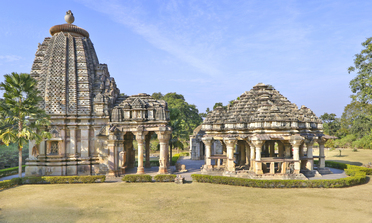
Badoli is situated in district Chittorgarh, on the bank of river Chambal. It was formerly a thickly forested area, but with the beginning construction of Rana Pratap Sagar dam, the site became populated. Col. James Tod, the British East India Company officer and orientalist, visited the site in 1821 CE and gave a graphic account of the temples.
There are nine extant temples at Badoli . L.K.Tripathi named these temples from number one to nine. Eight of these stand in two groups; the temples Nos. 1-3 near a pond and the remaining five Nos 4-8 are within an enclosure wall built of undressed stones. The temple no. 9 stands about half a mile to the north-east of the preceding two groups. Two temples are dedicated to Vishnu, one to Ganesha, two to Mahishasurmardini and four to Shiva. These temples are situated 30 miles south- east of Kota.
The Ghateshwara Temple is trianga on plan- Garbhagriha, Antarala and Ardhamandapa. This is east facing temple without Jagati. Its Vedibandha has bhitta, khura, kumbha, Kalasa, antarapatta and Kapotpali. Antarapatta is decorated with chequers which are not found in other temples. Kapotpali has Chandrasila motifs. Jangha of this temple consist Bhadra, Pratiratha and Karna. At the top of the Jangha, looped garland frieze appears. At Pratiratha, garland is replaced by Bharani. Varandhika has two layers of Kapotapalis separated by chequer antarapatta.
The principal niche contains ten armed Gajasurasamhara murti of Shiva on the right side, ten armed Nataraja Shiva on the back and 16 armed dancing Chamunda on the left. The panchratha latina sikhara has 12 bhumis with 11 bhumi- amalakas. The Shikhara has a series of Kapotpalis which are intervened of the Karnas by 11 bhumi -amalakas. Shikhara has jala of gavaksha-dormers. Its griva is decorated with two bands, in which the lower has dropping palmettes and the upper has one garland loops enclosing betel shaped palmettes. The Shikhara is crowned by amalakas, chandrika and Kalasha with overflowing foliage and custard apple- like fruit.
The antarala base corresponds with karna of Garbhgriha, of the wall facade of pratiratha. The cornice of the ardhmandapa consists of a projecting eave resting on sloping stones supported on four armed brackets, antarapatta decorated with chess- board design and a kapotpali. The roof of the ardhmandpa has four small curvilinear shikhara form at the corners and sculptured niches and flanking half niches with crowing pediments on the sides.
Ardhmandpa is rested on 6 pillars and two pilasters. it has four circular pillars and two heavier misraka pillars in the front row. At the lower part of misraka pillars , female are carved. Mukhmandapa 's ceiling is made of intersecting squares terminating in a nabhichchanda vitana of the kshipta variety. on the corners of the ceiling figures of Uma-Mahesavara, Lakshmi- Narayana, Brahma-Savitri and Ganesha-Vijneshvari are carved.
The sanctum doorjamb is of chatushakha type. the first two shakhas are plain. The third is padma yashti and the three facets of fourth shakha are plain. At the lower end of door jamb, the figurines of Ganga Yamuna, female attendant, Shaiva dvarpala and male attendants are depicted. The lintel has three sculptures, one in centre, eight armed Natraja as lalatbimba and at the corners icons of Brahma and Vishnu are depicted which are flanked by two flying garland bearers.
Rangmandapa is open and detached from main shrine. It has jadyakumbha, kapotpali and kumud. It has 24 pillars in which four central pillars are ornamented while 20 simple peripheral pillars are standing on asanapattas. Asanapatta rests on heavy plain square pillars with base at the corners and interventing plain slab like pilasters.
The central pillars of Rangmandapa are square with recessed corners. They consists of 5 parts, the base, the shaft, the capital, the dado and the top capital. The peripheral pillars have following parts- octagonal, 16 sided, circular section garland loop decoration toped by bharana and roll bracket. It is crowned by samvarana roof. It seems added later in the last quarter of the tenth century CE. The niches at the base of the roof contain images of Surya, Shiva, Indra, Agni, Brahma, Vishnu, Nirriti, Varuna, Ganesha, Kubera, Harihara etc.
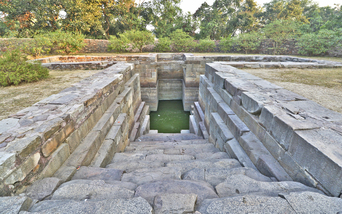
Badoli is situated in district Chittorgarh, on the bank of river Chambal. It was formerly a thickly forested area, but with the beginning construction of Rana Pratap Sagar dam, the site became populated. Col. James Tod, the British East India Company officer and orientalist, visited the site in 1821 CE and gave a graphic account of the temples. The Kund is situated to the north of the Sringar Chawari and is square in plan. It was built in 10th Century CE. It is accesible from three sides east, west, and north. The North side has a series of descending steps and is bigger than the other sides.
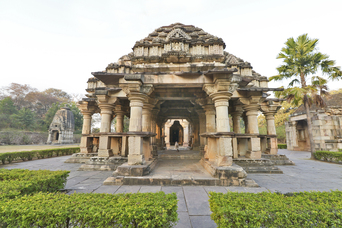
Badoli is situated in district Chittorgarh, on the bank of river Chambal. It was formerly a thickly forested area, but with the beginning construction of Rana Pratap Sagar dam, the site became populated. Col. James Tod, the British East India Company officer and orientalist, visited the site in 1821 CE and gave a graphic account of the temples.
There are nine extant temples at Badoli . L.K.Tripathi named these temples from number one to nine. Eight of these stand in two groups; the temples Nos. 1-3 near a pond and the remaining five Nos 4-8 are within an enclosure wall built of undressed stones. The temple no. 9 stands about half a mile to the north-east of the preceding two groups. Two temples are dedicated to Vishnu, one to Ganesha, two to Mahishasurmardini and four to Shiva. These temples are situated 30 miles south- east of Kota. The Rangamandapa popularly known as Sringar Chauri is situated in front of Ghateshwara temple. It is constructed initially in 10th century CE in Pratihara Style. It consists of a large hall with transepts and co-axial opening from the West and East.
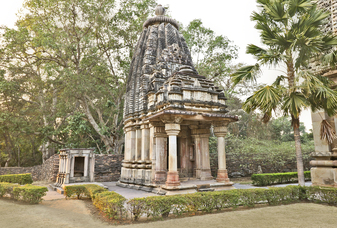
Badoli is situated in district Chittorgarh, on the bank of river Chambal. It was formerly a thickly forested area, but with the beginning construction of Rana Pratap Sagar dam, the site became populated. Col. James Tod, the British east india company officer and orientalist, visited the site in 1821 CE and gave a graphic account of the temples.
There are nine extant temples at Badoli . L.K.Tripathi named these temples from number one to nine. Eight of these stand in two groups; the temples Nos. 1 to3 near a pond and the remaining five Nos 4 to 8 are within an enclosure wall built of undressed stones. The temple no. 9 stands about half a mile to the north-east of the preceding two groups. Two temples are dedicated to Vishnu, one to Ganesha, two to Maheshasura mardini and four to Shiva. These temples are situated 30 miles south- east of Kota. This temple is also known as Maheshasura mardini temple and consists of garbhagriha, an antarala and a mukhamandapa. It is built of stone and is east facing, standing just south of the Ghateshwara temple. The pancharatha sanctum is adorned with a shikhara of ten storeys with nine bhumi-amalakas. The door-frame of the sanctum is of trishakha variety. The presence of a figure of dancing Maheshvari on the lintel as lalatabimba and of Parvati in the central niche on the sukanasa over the portico provides proof that this temple was dedicated to Maheshasura mardini. The edifice is assignable to the tenth century CE.
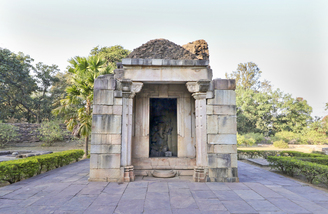
Badoli is situated in district Chittorgarh, on the bank of river Chambal. It was formerly a thickly forested area, but with the beginning construction of Rana Pratap Sagar dam, the site became populated. Col. James Tod, the British east india company officer and orientalist, visited the site in 1821 CE and gave a graphic account of the temples.
There are nine extant temples at Badoli . L.K.Tripathi named these temples from number one to nine. Eight of these stand in two groups; the temples Nos. 1-3 near a pond and the remaining five Nos 4-8 are within an enclosure wall built of undressed stones. The temple no. 9 stands about half a mile to the north-east of the preceding two groups. Two temples are dedicated to Vishnu, one to Ganesha, two to Mahishasurmardini and four to Shiva. These temples are situated 30 miles south- east of Kota. This Ganesh temple is facing south and comprising of a triratha Garbhagriha (sanctum) and vestibule projection. A colossal image of dancing Ganesha is enshrined in the sanctum.
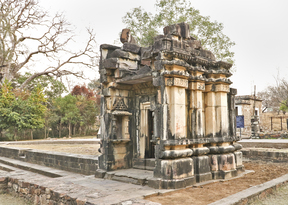
Badoli is situated in district Chittorgarh, on the bank of river Chambal. It was formerly a thickly forested area, but with the beginning construction of Rana Pratap Sagar dam, the site became populated. Col. James Tod, the British east india company officer and orientalist, visited the site in 1821 CE and gave a graphic account of the temples.
There are nine extant temples at Badoli . L.K.Tripathi named these temples from number one to nine. Eight of these stand in two groups; the temples Nos. 1-3 near a pond and the remaining five Nos 4-8 are within an enclosure wall, built of undressed stones. The temple no. 9 stands about half a mile to the north-east of the preceding two groups. Two temples are dedicated to Vishnu, one to Ganesha, two to Mahishasurmardini and four to Shiva. These temples are situated 30 miles south- east of Kota. This temple sanctum is rectangular in plan and dedicated to Seshashaiyi Vishnu facing north and is partially ruined. The image of Seshashaiyi Vishnu which was orignially placed in the sanctom or Garbhagriha is presently put in Archaeological Museum, Kota.
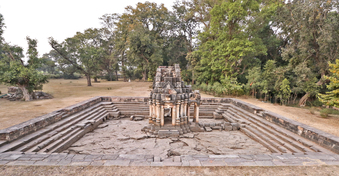
Badoli is situated in district Chittorgarh, on the bank of river Chambal. It was formerly a thickly forested area, but with the beginning construction of Rana Pratap Sagar dam, the site became populated. Col. James Tod, the British East India Company officer and orientalist, visited the site in 1821 CE and gave a graphic account of the temples.
This stone temple enshrining a Shivalinga stands in the centre of the tank. The temple faces east and consists of a pancharatha sanctum and a pillared portico of a single bay. It is datable to circa tenth century CE. This temple is built with sand stone and there is a tank at center,which collects water from a perennial fountain, fed by a perennial spring. The shikhar is in ruined condition.
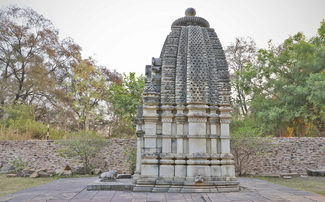
Badoli is situated in district Chittorgarh, on the bank of river Chambal. It was formerly a thickly forested area, but with the beginning construction of Rana Pratap Sagar dam, the site became populated. Col. James Tod, the British East India Company officer and orientalist, visited the site in 1821 CE and gave a graphic account of the temples.
There are nine extant temples at Badoli . L.K.Tripathi named these temples from number one to nine. Eight of these stand in two groups; the temples Nos. 1 to 3 near a pond and the remaining five Nos 4 to 8 are within an enclosure wall built of undressed stones. The temple no. 9 stands about half a mile to the north-east of the preceding two groups. Two temples are dedicated to Vishnu, one to Ganesha, two to Mahishasurmardini and four to Shiva. These temples are situated 30 miles south- east of Kota. The image of Trimurti Shiva is enshrined in the sanctum(garbhagriha) as a principal deity. This temple was built in Pratihara style and belongs to the 10th century CE facing east. The lintel of the sanctum shows a figure of Nataraj as lalatabimba.
Badoli is situated in district Chittorgarh, on the bank of river Chambal. It was formerly a thickly forested area, but with the beginning construction of Rana Pratap Sagar dam, the site became populated. Col. James Tod, the British East India Company officer and orientalist, visited the site in 1821 CE and gave a graphic account of the temples.
There are nine extant temples at Badoli . L.K.Tripathi named these temples from number one to nine. Eight of these stand in two groups; the temples Nos. 1-3 near a pond and the remaining five Nos 4-8 are within an enclosure wall built of undressed stones. The temple no. 9 stands about half a mile to the north-east of the preceding two groups. Two temples are dedicated to Vishnu, one to Ganesha, two to Mahishasurmardini and four to Shiva. These temples are situated 30 miles south- east of Kota. This temple is dedicated to Vishnu as Vamana avatara. In the sanctum (garbhagriha) image of four-armed Vishnu is enshrined. Temple is facing east. This temple belongs to Pratihara style of 10th century CE.